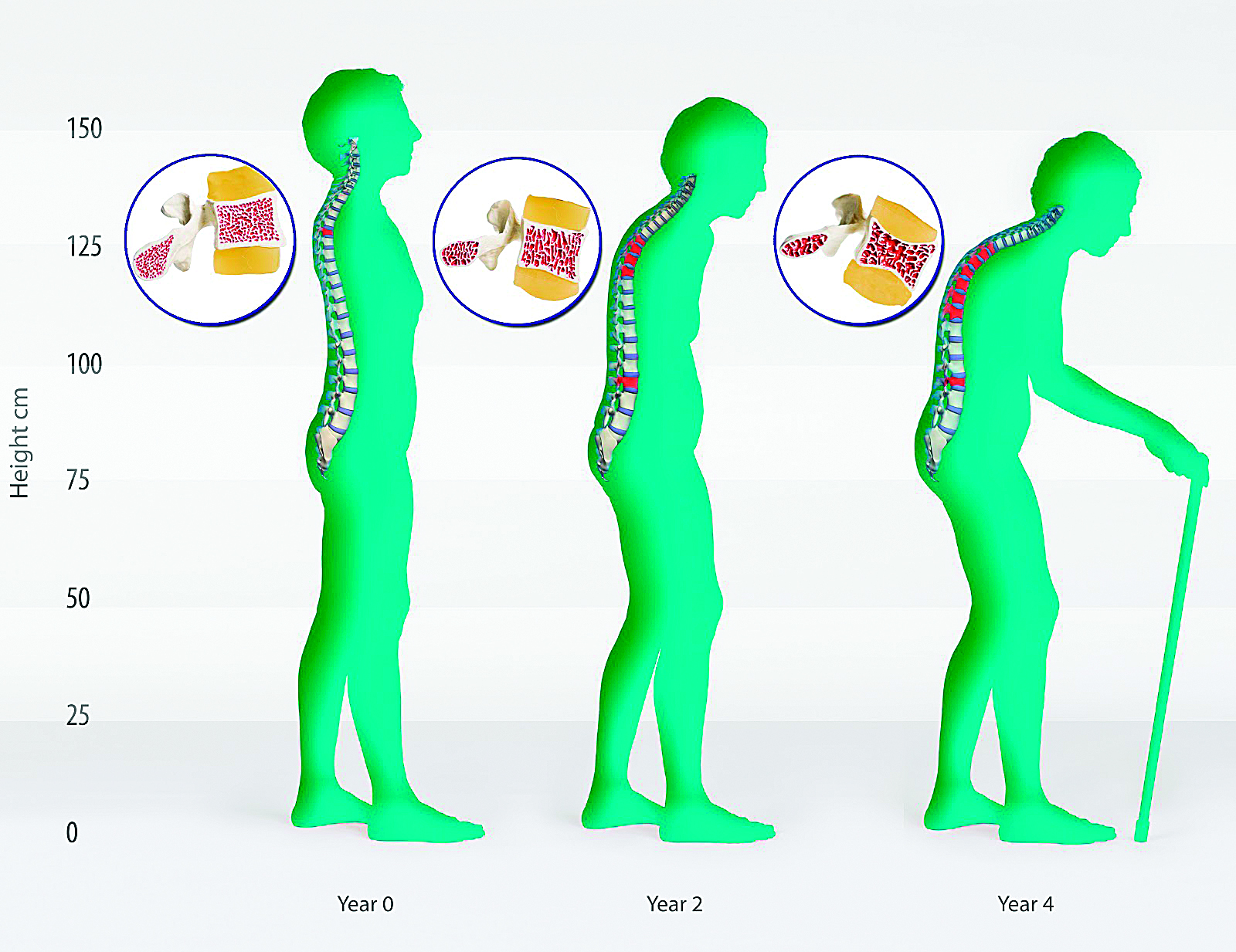
According to estimates, nearly 35 million Indians are affected by osteoporosis. Bone is living tissue which is constantly broken down and replaced, as a normal bodily process. When you’re young, your body makes new bone faster than it breaks down old bone and your bone mass increases. Most people reach their peak bone mass by their early 20s. As people age, bone mass is lost faster than it’s created. Osteoporosis occurs when the creation of new bone doesn’t keep up with the removal of old bone, causing bones to become weak and so brittle that a fall or even mild stresses such as bending over or coughing, could cause a fracture! Osteoporosis-related fractures most commonly occur in the hip, wrist or spine.
Symptoms: Though there aren’t typical symptoms in the early stages of bone loss, once the bones have been weakened by osteoporosis, one may undergo symptoms that include back pain caused by a fractured or collapsed vertebra; loss of height over time; a stooped posture; bone fractures that occur unexpectedly.
Risk Factors are numerous which increase the likelihood of contracting osteoporosis. Some are unchangeable and not possible to control, but many can be controlled. It is important to understand the risk factors in order to keep
Osteoporosis at bay:
Factors You Can’t Control:
• Gender: Women are more susceptible than men.
• Age: The older you get, the greater the risk.
• Race: Indians are at a greatest risk of osteoporosis
• Heredity: Having a parent or sibling with osteoporosis increases your risk factor
• Body frame: People with a small body frame are at a higher risk as they have less bone mass to draw from as they age.
Factors You Can Control:
• Hormone levels: Osteoporosis is more common in people who have an excess or deficit of certain hormones in their bodies. For eg., lower sex hormone levels tend to weaken bone or reduction of estrogen levels in women during and post menopause; or gradual reduction in testosterone in men with age. Also, too much thyroid hormone can cause bone loss. Osteoporosis is also associated with overactive adrenal and parathyroid glands.
• Dietary Factors: Osteoporosis is more likely to occur in people who have low calcium intake as that contributes to diminished bone density, early bone loss and an increased risk of fractures. Also, people with eating disorders, or those who’ve undergone Gastrointestinal/bariatric surgery are more prone to this ailment.
• Bad Lifestyle Choices: A sedentary or inactive lifestyle increases your risk of osteoporosis, as does excessive alcohol consumption and use of tobacco.
• Medical Conditions: also raises the risk of contracting Osteoporosis, especially for those ailing from Celiac disease, Inflammatory bowel disease, Kidney or liver disease, Cancer, Lupus, Multiple myeloma or Rheumatoid arthritis.
Diagnosis:
Bone density is measured by a machine that uses low levels of X-rays to determine the proportion of mineral in your bones. During this painless test, you are made to lie down on a table as a scanner passes over your body. In most cases, only a few bones are checked — usually in the hip, wrist and spine. Treatment recommendations are often based on an estimate of your risk of breaking a bone in the next ten years using information such as the bone density test. If the risk is not high, treatment might not include medication and could focus instead on modifying risk factors for bone loss and falls.
Preventing Osteoporosis:
Since Osteoporosis is more preventive than corrective in nature, here are a few vital tips to help you practice precaution against this malady:
• Exercise Your Bones: Just like muscles, your bones get stronger if you give them a workout. Weight-bearing exercises are best for your bones. These force your body to work against gravity as you move, prompting the body to make new bone. Weight-bearing exercises include aerobics, climbing stairs, dancing, jogging, tennis and other racket sports, running, tai chi, walking, water aerobics, yoga, etc. Strength training or resistance exercises (weight-lifting under supervision) is also key to preventing osteoporosis. Your muscles pull on your bones when you work them. That builds bone strength.
• Ensure a nutritious diet with adequate calcium intake. Avoid under-nutrition, particularly the effects of severe weight-loss diets and eating disorders. Ensure adequate protein intake, as per your weight and age. Maintain an adequate supply of vitamin D.
• Avoid smoking and second-hand/passive smoking.
• Avoid heavy drinking
• Get Adequate Sleep: A minimum of six to eight hours
• Prevent Falls: Wear low-heeled shoes with nonslip soles. Be careful on slippery surfaces that might cause you to trip or fall. For elders, install grab bars just inside and outside your shower door, and make sure you can get into and out of your bed easily.
- તમે ઇન્જેક્શન આપેલા તરબૂચ તો નથી ખાઈ રહ્યા ને? - 27 April2024
- પિતાના હાથની છાપ.. - 27 April2024
- વિસ્પી ખરાડી ફિટ ઈન્ડિયા મૂવમેન્ટનાબ્રાન્ડ એમ્બેસેડર તરીકે નિયુક્ત - 27 April2024
